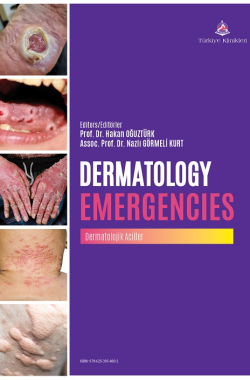Pityriasis Rosea
Burak Emre GİLİK
Sincan Training and Research Hospital, Clinic of Emergency Medicine, Ankara, Türkiye
Burhaneddin Burak YURT
Ankara Etlik City Hospital, Clinic of Emergency Medicine, Ankara, Türkiye
Gilik BE, Yurt BB. Pityriasis rosea. In: Oğuztürk H, Görmeli Kurt N, eds. Dermatologic Emergencies. 1st ed. Ankara: Türkiye Klinikleri; 2025. p.116-20.
ABSTRACT
Pityriasis rosea (PR) is a benign, self-limiting skin condition with an unclear etiology. It frequently involves the torso and extremities and typically begins with a distinct herald patch, a red, scaly lesion that appears before the development of a broader rash. PR generally resolves on its own within 6-8 weeks. The term “pityriasis” refers to the fine, bran-like scales seen on the skin, while “rosea” denotes the pinkish hue of the lesions. Although Camille Melchoir Gibert, a French physician, first described PR in 1860, it was known earlier under different names, such as roseola annulata, a term introduced by British dermatologist Robert Willan in 1798. PR is most commonly observed in individuals aged 10-43 and tends to be more prevalent during the spring and fall. It is rare in infants and older adults, and there is no significant difference between sexes. The reactivation of human herpesviruses HHV-6 and HHV-7 is commonly suspected as a cause of PR. Additionally, PR-like rashes have been reported after vaccinations and certain medications, although these rashes often lack the herald patch typical of PR. Clinically, PR may start with mild symptoms like headache, fever, and malaise in about 5-10% of patients. The herald patch is usually a large, red plaque with fine scaling, often located on the trunk, neck, or proximal extremities. This patch is followed by smaller, oval lesions aligning with skin lines, particularly on the back, forming the “Christmas tree” pattern. Pruritus, affecting up to 75% of patients, can vary from mild to severe. Diagnosis is primarily clinical, with the herald patch being a key indicator. While skin biopsy is rarely necessary, it can help rule out other conditions like eczema, tinea corporis, or secondary syphilis. Routine lab tests are generally not required, but potassium hydroxide (KOH) preparation, syphilis serology, and throat cultures may be used to exclude other diagnoses. Treatment focuses on alleviating symptoms rather than targeting the underlying cause. There is no specific treatment for PR; the condition resolves on its own without the need for targeted therapy. Options include antihistamines for itching, topical corticosteroids for inflammation, and oatmeal baths for soothing the skin. For severe or persistent cases, antivirals like acyclovir or phototherapy might be considered. PR is not contagious and does not require isolation.
Keywords: Herpesvirus 6, human; herpesvirus 7, human; histamine H1 antagonists; pityriasis rosea; pruritus; skin diseases, papulosquamous
Kaynak Göster
Referanslar
- Drago F, Broccolo F, Rebora A. Pityriasis rosea: an update with a critical appraisal of its possible herpesviral etiology. J Am Acad Dermatol. 2009;61(2):303-18. [Crossref] [PubMed]
- Holubar K. Robert Willan's description and treatment of cutaneous diseases 1797/1798: a bicentennial. J Invest Dermatol. 1998;110(1):101. [Crossref] [PubMed]
- CORSON EF, LUSCOMBE HA. Coincidence of pityriasis rosea with pregnancy. AMA Arch Derm Syphilol. 1950;62(4):562-4. [Crossref] [PubMed]
- Watanabe T, Sugaya M, Nakamura K, Tamaki K. Human herpesvirus 7 and pityriasis rosea. J Invest Dermatol. 1999;113(2):288-9. [Crossref] [PubMed]
- Oh CW, Yoon J, Kim CY. Pityriasis rosea-like rash secondary to intravesical bacillus calmette-guerin immunotherapy. Ann Dermatol. 2012;24(3):360-2. [Crossref] [PubMed] [PMC]
- Papakostas D, Stavropoulos PG, Papafragkaki D, Grigoraki E, Avgerinou G, Antoniou C. An atypical case of pityriasis rosea gigantea after influenza vaccination. Case Rep Dermatol. 2014;6(1):119-23. [Crossref] [PubMed] [PMC]
- Mahajan K, Relhan v, Relhan AK, Garg vK. Pityriasis Rosea: An Update on Etiopathogenesis and Management of Difficult Aspects. Indian J Dermatol. 2016;61(4):375-84. [Crossref] [PubMed] [PMC]
- Rotstein E, Rotstein H. Drug eruptions with lichenoid histology produced by captopril. Australas J Dermatol. 1989;30(1):9-14. [Crossref] [PubMed]
- Ghersetich I, Rindi L, Teofoli P, Tsampau D, Palleschi GM, Lotti T. Eruzione cutanea da captopril "pitiriasi rosea-like" [Pityriasis rosea-like skin eruptions caused by captopril]. G Ital Dermatol venereol. 1990;125(10):457-9. Italian. [PubMed]
- Wilkinson SM, Smith AG, Davis MJ, Mattey D, Dawes PT. Pityriasis rosea and discoid eczema: dose related reactions to treatment with gold. Ann Rheum Dis. 1992;51(7):881-4. [Crossref] [PubMed] [PMC]
- Lizeaux-Parneix v, Bedane C, Lavignac C, Bernard P, Bonnetblanc JM. Réactions cutanées aux sels d'or [Cutaneous reactions to gold salts]. Ann Dermatol venereol. 1994;121(11):793-7. French. Erratum in: Ann Dermatol venereol 1995;122(8):529. [PubMed]
- Jacyk WK. Pityriasis rosea in Nigerians. Int J Dermatol. 1980;19(7): 397-9. [Crossref] [PubMed]
- Drago F, vecchio F, Rebora A. Use of high-dose acyclovir in pityriasis rosea. J Am Acad Dermatol. 2006;54(1):82-5. [Crossref] [PubMed]
- Ehsani A, Esmaily N, Noormohammadpour P, Toosi S, Hosseinpour A, Hosseini M, et al. The comparison between the efficacy of high dose acyclovir and erythromycin on the period and signs of pitiriasis rosea. Indian J Dermatol. 2010;55(3):246-8. [Crossref] [PubMed] [PMC]
- Amatya A, Rajouria EA, Karn DK. Comparative study of effectiveness of oral acyclovir with oral erythromycin in the treatment of Pityriasis rosea. Kathmandu Univ Med J (KUMJ). 2012;10(37):57-61. [Link]
- Drago F, Broccolo F, Zaccaria E, Malnati M, Cocuzza C, Lusso P, Rebora A. Pregnancy outcome in patients with pityriasis rosea. J Am Acad Dermatol. 2008;58(5 Suppl 1):S78-83. [Crossref] [PubMed]
- Cook B, Crutchfield CE. Pityriasis rosea. Dermatol Nurs. 2006;18(4):370. [PubMed]
- Alajmi A, Jfri A, Pehr K. Pityriasis Rosea: Risk and Treatment During Pregnancy. J Cutan Med Surg. 2020;24(2):207-8. [Crossref] [PubMed]

